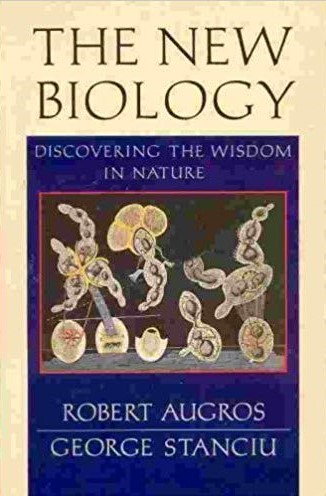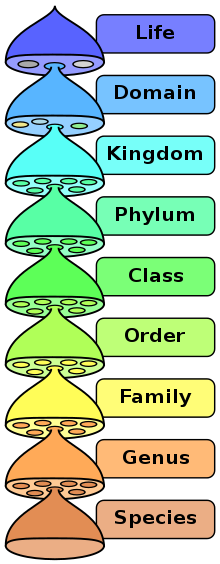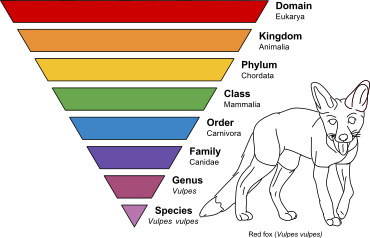|
home | what's new | other sites | contact | about |
||||||
|
Word Gems exploring self-realization, sacred personhood, and full humanity
Augros & Stanciu's George Stanciu, PhD, theoretical physics
return to "Evolution" main-page
Editor's note: The major concepts of the following are from Augros & Stanciu's The New Biology, chapter six, "Origins."
Editor’s note: Two diagrams below are from Wikipedia articles on biological taxonomy. These will help most of us, non-biologists, understand an important point made by The New Biology. We’ll need to define some basic terms employed in the classification of organisms before examining Augros and Stanciu’s work.
The above diagram would appear to offer a neat-and-tidy schema; but this is not altogether the case. A newcomer to the area of classifying organisms is immediately met by many voices. There are many competing ordering plans, with the above conceptual framework presenting but a generalized overview. For example, the term species traditionally signified “the largest group of organisms in which any two individuals of the appropriate sexes or mating types can produce fertile offspring, typically by sexual reproduction.” However, in recent times, five other definitions have jostled their way into the fray in terms of labeling species. An awareness of this multiplicity is important to our investigations because at times we are presented with headlines such as “New Species Created” or some such, but the question must be asked, “created according to which conveniently-elastic definition of species?” But let us not mire ourselves inordinately with too many details at the moment but stick to general concepts. The above taxonomic chart, in broad outline, works this way: The classifications -- Species, Genus, Family, Order, Class, Phylum, Kingdom, Domain – represent a hierarchy. A term on the chart will incorporate, under it, more specific, more differentiated, aspects of a particular life-form. In other words, the higher the positioning on the chart, the more generalized is the information.
For example, in this diagram featuring the “chain of being” for the red fox, Family would include extended members such as wolves, jackals, dogs, and others. Genus offers a narrowing subset comprising all groups of foxes. And Species takes us to the particular delineation of the red fox. Concerning our purposes at hand, that of exploring a point made by Augros and Stanciu, we’ll want to appreciate the meaning of a term near the top of the ordering hierarchy - Phylum. This word often refers to “groupings of organisms based on general specialization of body plan." The sorting process of Phylum could involve body plans with or without spinal columns (or "notochords"). On the red-fox diagram, we see this in play with Phylum given as “chordata.”
from the text of The New Biology The pattern of fossil evidence over the whole of geological history shows a long-term decrease in the number of phyla [plural form of “phylum”] and other higher categories despite an overall increase in the number of different species. The result is a greater intensity of diversification within progressively smaller confines. Gould offers the example of marine animals: “Our modern seas are dominated by just a few groups – primarily clams, snails, crabs, fishes, and echinoids – each with far more species than any Paleozoic [600 - 225 million years ago] phylum ever attained… [possibly] only half the species that grace our modern oceans, but they were distributed over a vastly expanded range of basic body plans. And this steady decrease of [phyla]… in the face of a strong increase in numbers of species… may represent the most outstanding trend of our fossil record.” the fossil record indicates that evolution is winding down Zoologist James Brough of the University of Wales sees “evolution as a decelerating process.” He points out that the phyla of today’s animals have existed since the Cambrian age, 500 million years ago. No new phyla have developed since then… In the same way, new classes within phyla stopped emerging during the lower Paleozoic era, about 400 million years ago… New orders stopped emerging at the end of the Mesozoic era, about 60 million years ago. Brough, noting a decrease in the production of new families, comments on this general trend: “Evolution seems to have worked in a series of more and more restricted fields with large-scale effects steadily decreasing … as to the future, evolution may go on working in smaller and smaller fields until it ceases altogether.” This trend argues that evolution is not a perpetual or unlimited force, but rather is subject to constraints and plays itself out in a large but finite time. The second law of thermodynamics says that the universe as a whole is running down. The fossil record says the same for the process of evolution. This “pattern of shift from few species in many groups to many species in fewer groups” flatly contradicts Darwinian gradualism; for if evolution proceeded by species accumulating small variations, we should see over long periods new orders, classes, and phyla emerging with increasing frequency. But just the opposite occurs in the fossils. Darwin’s model is backward. from Amit Goswami’s Creative Evolution: Dr. Gerald Schroeder: “These [Cambrian] fossils … indicate that all animal phyla appeared almost simultaneously 530 million years ago in the [Cambrian Explosion]. All further development was confined to variations within each phylum. One of the great mysteries of animal evolution is why no new phyla have appeared since that Cambrian explosion of life.” … there have not been any new phyla since the Cambrian age… And new classes within a phylum stopped emerging some 400 million years ago… The next lower hierarchy, new orders, stopped emerging about 60 million years ago… Richard Goldsmith [writes]: “Can this mean anything but that the type of the phylum was evolved first and later separated into the type of classes, then into orders, and so on down the line.” … biological creativity [reflects the usual method of creativity at large]… All fields of human creative endeavor have one thing in common: Creativity in a new field takes off with an enormous flare. With time and proliferation of (subfields), complexity develops and the speed of progress slows. The same pattern is observed in biological evolution… 50 million years ago [we find that] mammals suddenly exhibited an amazing [burst of variety] into about 24 different orders – rabbits, rodents, elephants, [etc.]. The resultant Age of Mammals took only 12 million years to establish itself. After that the progress slowed down.
|
||||||
|
|




